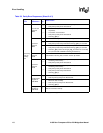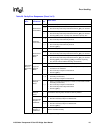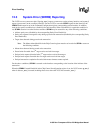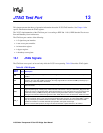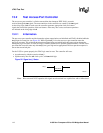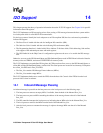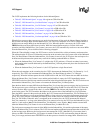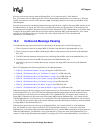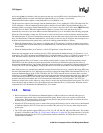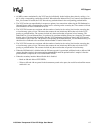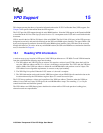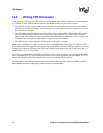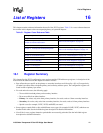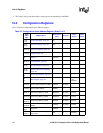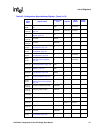
116 21555 Non-Transparent PCI-to-PCI Bridge User Manual
I2O Support
and asserts p_inta_l to indicate to the host processor that one or more MFAs exist in the Outbound Post_List .
Signal p_inta_l remains asserted until either the Outbound Post_List Counter is zero and the
outbound prefetch buffer empties, or the Outbound Post_List Mask bit is set.
The host processor removes the message from the Outbound Post_List by reading the 21555 CSR offset 44h. The
21555 maintains a 2 Dword outbound prefetch buffer to hold the next two MFAs from the Outbound Post_List.
When this buffer is not empty and the Outbound Post_List Counter is non-zero, the 21555 returns TRDY# and the
next MFA from its buffer. When the internal buffer empties as a result of this read operation, the 21555
automatically reads one or two more MFAs from the Outbound Post_List as described in the following paragraph.
When the 2 Dword buffer is empty, the 21555 treats a read to location 44h as a delayed memory read transaction.
The address that the 21555 uses to initiate the transaction on the secondary bus is the current value of the Outbound
Post_List Head Pointer. When the Outbound Post_List Counter is non-zero, the 21555 places the read request in a
downstream delayed transaction queue entry reserved for fetching outbound MFAs as follows:
• When the Outbound Post_List Counter is 2 or higher, the 21555 performs a 2 Dword secondary bus memory
read starting at the location addressed by the Outbound Post_List head pointer and places the read data in the 2
Dword buffer.
• When the Outbound Post_List Counter is 1, the 21555 performs a single Dword read.
When the read completes on the secondary bus, the 21555 decrements the Outbound Post_List Counter by 1 or 2,
respectively. The 21555 increments the Outbound Post_List Head Pointer by either 1 or 2 Dwords, respectively, as
well. When the initiator repeats the read of CSR location 44h, the 21555 returns the next MFA to the host.
When the Outbound Post_List Counter is zero and the prefetch buffer is empty, the 21555 immediately returns
FFFFFFFFh to the host and does not enter the transaction in the delayed transaction queue and also does not
decrement the Outbound Post_List Counter. When the counter decrements to zero and the 2 Dword prefetch buffer
is empty, the 21555 deasserts p_inta_l, indicating that there are no more posted MFAs in the Outbound Queue.
Once the host processor consumes the outbound message from the local processor, it replaces the empty MFA onto
the end of the Outbound Free_List. When the host processor replaces the empty MFA to the Outbound Free_List, it
writes the Outbound Queue at the 21555 CSR offset 44h. The 21555 treats the write to location 44h as a posted
write; that is, it returns TRDY# to the initiator and places the write data in the downstream posted write queue. The
21555 translates the address to the current value of the Outbound Free_List tail pointer. Once the empty MFA is
queued in the posted write buffer, the 21555 increments the Outbound Free_List tail pointer. The 21555 can
continue to accept writes to this address as long as there is room in the downstream posted write queue. The 21555
writes the data to the secondary bus location addressed by the Outbound Free_List tail pointer. When the write is
completed, the 21555 increments the Outbound Free_List counter.
14.3 Notes
• Read transactions to I2O Inbound and Outbound Queues at 40h and 44h are not ordered with respect to
transactions in the posted write or delayed transaction queues. Reads to these two registers will not flush
posted writes. Write transactions to these registers are placed in the posted write queue, and follow the same
ordering rules as other posted memory writes.
• When the 21555 detects parity errors, a master abort or target abort during a read or write access to the Inbound
or Outbound Queues, the 21555 treats the error condition the same way as it does any other delayed read or
posted write.
• The 21555 queue pointers support FIFO sizes of 256, 512, 1K, 2K, 4K, 8K, 16K, and 32K entries. The number
of entries is selectable in the Table 78, “Chip Control 1 Register” on page 160. The wrap function for all of the
I2O pointers maintained by the 21555 is performed in hardware; therefore, all FIFOs must be located in an
aligned address boundary.



